Noble Gas Configuration For Helium
What do some neon signs, political party balloons, and few bulbs take in common? They all incorporate noble gases.
In this article, lets explore what are noble gases, where are they placed in the periodic tabular array, some of the key properties of noble gases and their users.
At the end of the article, you can also find interesting noble gases worksheets that you can use for your classroom or at-home practice.
What are Noble Gases?
Noble gases are monatomic, odourless gases and have absolutely no reactivity towards any other chemical element or compound.
Who Discovered Noble Gases?
In the year 1894, William Ramsay performed an interesting experiment. He was curious about the 'Other Gases' present in the air, apart from Oxygen and Nitrogen.
For the experiment, he segregated Oxygen first, followed by Nitrogen to isolate the 'Other Gases'. Ramsay did this to study and understand their properties without whatever intermission from the remaining major gases.
On Separation, he institute that indeed in that location is a gas present in very minute quantity. He later named that gas as 'Argon', pregnant idle in Greek.
Hence, William Ramsay is credited equally the start to discover Noble Gases.
Why Are They Called Noble Gases?
Dignity usually refers to something/someone who is unique and different from the expected qualities. These gases, which testify entirely different behaviour compared to gases of other elements, are hence named 'Noble Gases'.
They are also named so because of their amnesty to whatever kind of influence from other elements, which is as well a characteristic of 'Noble'.
Where Are Noble Gases Institute in Nature?
The master source of Noble Gases in Earth's atmosphere. These gases are obtained physically by processes similar Liquefaction and Partial Distillation.
Liquefaction is simply the conversion of the element's gas country to a liquid country.
Fractional Distillation is more than of a separating process than conversion. It separates the Noble Gases from the mixture of gases present in the air.
Even so, not all Noble Gases are obtained from air. For instance, Helium and Radon, the topmost and bottommost elements of the Noble Gases Group, are not found in the air.
Helium is obtained from Natural Gas Wells. The gases emitted from these wells is filled with impurities. This then undergoes a purification process that results in pure Helium.
Radon, on the other hand, is a Radioactive element. Radon is e'er nowadays in compound class. Pure Radon is a product of spontaneous radioactive decomposition. Spontaneous because the nuclei of Radon atoms decay by emitting energy and particles.
What Are the Colours of Noble Gases?
In their elemental phase, i.e., not in a combined state with other elements. Noble Gases are colourless. The first impression of beingness called the fancy name of existence 'Noble' may give a false supposition of having colour.
Although this is the case, however, there are some instances where they 'emit' colour instead of 'showing' colour.
When valence electrons of Noble Gases are excited to a higher energy level than their present free energy level, they absorb energy.
On dexcitation, they autumn back to their original energy level, in the process of which they 'emit' free energy.
This 'emission' of energy is what is referred to as them 'showing' colour. Otherwise, in their not-reactive, monoatomic stage, they exercise not take any colour.
These 'emissions' autumn under the 'Visible' region of the colour spectra. This is because the wavelength and frequency of these emissions match the visible range, hence visible to our eyes.
The following are the colours of respective Noble Gases –
Helium (He) – Pink
Argon (Ar) – Ruby-red-Orange
Krypton (Kr) – Blue
Xenon (Xe) – Pale Green
Radon (Rn) – Stake Blueish
Where Are Noble Gases in The Periodic Table?
The Periodic Table is a systematic organisation of all elements that exist in the world. The orderly placing is essential to study and understand each of their characteristics.
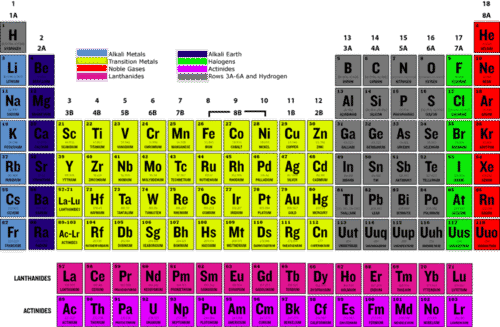
The location of Noble Gases can be described as follows –
Position co-ordinate to Group Number
Group refers to the vertical column in the Periodic Tabular array, and there are 18 in information technology.
To improve understand all the elements in the periodic table, the Groups are divided into 'Group A' and 'Group B'.
Grouping A refers to the 1st, 2d and then 13 through 18 groups, while Group B refers to groups third to twelfth. The quondam occupies the farthest left and farthest correct, and the latter occupies the middle region.
The one on the uttermost correct of the Periodic Tables is the eighth vertical column or the 8th Group. This 8th Grouping is where all the Noble Gases are nowadays.
Position co-ordinate to Period Number
Period refers to the horizontal row in the Periodic Tabular array, and they are a total of vii in it.
At the end of each of the 7 periods, 1 Noble gas is present. This implies that all vii periods take at least 1 Noble Gas in them.
Combined Location
To name the location of a Noble Gas, the Group Number is followed by the Menses Number.
For example, let united states locate Xenon. So, Xenon is said to be in Eight A Group and 5th Menstruation.
What Are the Elements Comprising the Noble Gases Family?
Noble Gases are 7. The 7th is the latest to be discovered a radioactive element, just similar the one above it, Radon.
Listing of Noble Gases/Elements
The following is the Noble Gases list, in their increasing atomic number (mentioned in the brackets), downward the grouping.
Helium (two)
Neon (10)
Argon (18)
Krypton (36)
Xenon (54)
Radon (86)
Oganesson (118)
What is the Electronic Configuration of Noble Gases?
- Definition: Electronic Configuration refers to the number of electrons present in an chemical element.
The Electronic Configuration acts equally a detailed limerick of the number of electrons present in each of the inner and outer shells of the element.
To understand Electronic Configuration, you get-go need to empathise the 'Octet Rule'.
The Octet Rule refers to the presence of 8 electrons in the outermost shell of each element. Therefore, any element having the octet configuration is the most stable.
It then happens that all the elements of Noble Gases have a total of 8 electrons in their outermost shells, hence making them the most stable elements of the unabridged periodic table.
This condition is used as a contracted class for writing the electronic configurations of other elements, both noble gases and not-noble gases.
The following is the listing of Noble Gases with their Electronic Configurations –
Helium (2) – 1s2
Neon (x) – [He] 2s2 2phalf dozen
Argon (18) – [Ne] 3s2 3p6
Krypton (36) – [Ar] 3d10 4sii 4p6
Xenon (54) – [Kr] 4d10 5s2 5phalf-dozen
Radon (86) – [Xe] 4ffourteen 5d10 6s2 6pvi
Oganesson (118) – [Rn] 7s2 7pvi 5f14 6d10
The following is the list of II A Group element, showing the example of how Noble Gases are used to write their Electronic Configurations –
Beryllium (four) – [He] 2s2
Magnesium (12) – [Ne] 3s2
Calcium (xx) – [Ar] 4s2
Strontium (38) – [Kr] 5s2
Barium (56) – [Xe] 6s2
Radium (88) – [Rn] 7stwo
What is the Valency of Noble Gases?
- Definition: Valency is simply the number of electrons in the outermost shell of an element.
There are 2 definitions of what Valency means regarding Noble Gases.
In i case, the number of electrons in the outermost shell of Noble Gases is eight, and then, eight is considered the Valency of Noble Gases.
On the other manus, since the Noble Gases follow the dominion concerning the Octet Rule, they are considered not to accept any electrons that tin human activity every bit 'Valence electron'. Hence, this status states the valency of Noble Gases as 0 and not 8.
Full general Characteristics of Noble Gases
One characteristic mutual to all Noble Gases is that they all have an outer electronic configuration equally 8.
Also, they all are Colourless (in their basis-level state and not excited state) and Odourless.
They are always plant as Mono atoms, pregnant well-nigh of the time are constituted of i cantlet.
Properties of Noble Gases
Properties of Noble Gases give us an idea of how they react or not react in certain weather and situations. For like shooting fish in a barrel comprehension, these are divided into ii.
Physical Properties
- Definition: Physical Properties refer to the properties of Noble Gases where there are no structural changes or element/compound addition to the elements.
- What are the Boiling Points of Noble Gases?
- Boiling Signal- Humid Indicate refers to the temperature at which an element transforms from its liquid state to a gaseous country.
The nucleus of each element has an attraction towards each of the electrons that environment it. This attraction pulls the electrons towards themselves. This is too referred to as 'Intermolecular forces of attraction'.
In Noble Gases, downwards the group, atomic radii increases. This is considering 1 shell keeps on adding.
With the improver of each beat out, the altitude between the nuclei and the outermost electron increases, reducing the intermolecular forces of attraction.
Due to the to a higher place two phenomena of increase in atomic radii and decrease in intermolecular forces of attraction, Boiling Signal increases down the grouping.
Therefore, at the height of the Group, the Boiling Point is the everyman and most negative, and at the bottom of the Group, the Humid Signal is the highest and least negative.
The following are the Noble Gases with their respective Boiling Points –
Helium: -272℃
Neon: -246℃
Argon: -186℃
Krypton: -152℃
Xenon: -107℃
Radon: -62℃
Oganesson: 177℃ (experimentally predicted)
- Why are Noble Gases Stable?
- Stability- Stability refers to the state of remaining unchanged.
Because the Noble Gases follow the Octet Rule and have 8 electrons in the outermost shell of their elements, they are the most stable of elements. Octet Rules equals Stability.
They are not interested in whatsoever chemical element or compound near them or taken shut to any element or compound. They are happy and stable where they are.
Nonetheless, Stability decreases downwards the Noble Gases Grouping. This is because of an increase in diminutive radii and a decrease in intermolecular forces of allure.
Helium has the shortest atomic radius and the strongest intermolecular forces of attraction, hence most stable at the Grouping's pinnacle.
Radon has the longest atomic radius and the weakest intermolecular forces of attraction, hence least stable at the Group'southward lesser.
(Oganesson's properties are all the same under study).
- What are the Ionization Energies of Noble Gases?
- Ionization Energy- Ionization Free energy is the free energy required to remove an electron from the outermost vanquish of an cantlet, to make the atom an ion.
Ions are charged atoms. They either possess a positive or a negative accuse if they lose or proceeds an electron, respectively.
The number of electrons lost or gained is written along with the accuse on the upper right corner of the element symbol.
The formation of ions is non like shooting fish in a barrel in Noble Gases due to them beingness extremely stable.
Unremarkably, atoms form ions to get closer to forming an octet configuration or to grade an octet configuration directly. This is done past sharing electrons between the particles to form Covalent Bonds.
Covalent Bonds are formed to give stability, which is what each atom desires.
Even so, in Noble Gases, since they already possess eight electrons in their outer crush, why would they want to lose or proceeds valence electron(s)?
For this to happen (which rarely occurs), the threshold energy required is very loftier to pull the valence electron(due south) away from the intermolecular forces of allure between the nucleus and the electron(s) and out of the outermost shell.
Therefore, Noble Gases have high Ionization Energies.
Period-wise, Noble Gases have the highest Ionization Energies in their corresponding periods. However, Grouping-wise, a subtract in the trend is shown.
As we movement down the Noble Gases Group, the atomic radii increase, and the intermolecular forces subtract.
These two factors combine and brand valence electron(due south) exit from the bottom elements easier than the top elements.
Helium has the highest Ionization Energy, while Radon has the everyman Ionization Energy.
(Oganesson'south Stability notwithstanding nether study).
- Are Noble Gases Metals/Non-metals?
- Metal Character- Metallic Graphic symbol refers to the ease of the cantlet to lose valence electron(s).
In other words, this is also referred to as Electropositivity.
In the Noble Gases Group, as nosotros motion from meridian to bottom, an outer vanquish is observed with each menses.
This improver increases the atomic radii and decreases the intermolecular forces of attraction between the nucleus and the valence electron(southward).
Due to the above ii factors, it becomes easier for the atom to lose valence electron(s) having no business firm hold on them, thus giving it a positive charge(southward)
Therefore, Metal grapheme increases down the grouping.
Helium is the to the lowest degree Metallic, while Radon is the most Metallic.
(Oganesson'south Metallic Graphic symbol is nevertheless nether report).
- Non-Metal Character- Non-Metallic Graphic symbol refers to the ease of the atom to gain valence electron(due south).
In other words, this is also referred to every bit Electronegativity.
In the Noble Gases Group, as nosotros movement from elevation to bottom, an outer shell is observed with each period.
This addition increases the atomic radii and decreases the intermolecular forces of attraction betwixt the nucleus and the valence electron(s).
Due to the higher up 2 factors, information technology becomes harder for the atom to gain any more valence electron(s) having no house concord on them, thus non giving it a negative accuse(s)
Therefore, the Non-Metal character decreases down the grouping.
Helium is the nigh Non-Metallic, while Radon is the least Non-Metallic.
(Oganesson'southward Non-Metal Character is still under study).
- How is the Reactivity of Noble Gases?
- Reactivity- Reactivity refers to a reaction or non-reaction to specific changes in atmospheric condition of an atom.
The reactivity of Noble Gases is dependent on Stability and Ionization Energy.
Noble Gases are the most stable of compounds with very loftier Ionization Energies. All the same, for whatever reactivity to occur, a large amount of piece of work needs to be done, which is highly undesirable.
Therefore, Noble Gases are highly Unreactive/Non-reactive elements. Still, they can exist fabricated to react if certain favourable conditions are created.
- Why are Noble Gases Inert?
- Inertness- Inertness refers to the ability to be non-reactive and maintain stability.
The inertness of Noble Gases is dependent on Stability and Ionization Free energy.
Noble Gases are the most inert of compounds with very loftier Ionization Energies. For the inertness to be removed, a lot of piece of work needs to be washed, which is highly undesirable.
Therefore, Noble Gases rarely class bonds with other atoms. However, they can be made to lose their inertness if certain favourable conditions are created.
- What are the Charges of Noble Gases?
- Charge- Charge refers to the valence electron(southward) lost or gained on reaction with an element of the same species or different with another chemical compound.
When an chemical element is said to take charge(due south), it tin can no longer exist called an atom merely should be called an ion, irrespective of whether that charge is positive or negative.
Charge Formation is the ability of an atom to carry out the loss or proceeds of electron(s). This is influenced by Stability and Ionization Energies.
For Noble Gases to undergo charge formation, a big amount of piece of work needs to be done, which is highly undesirable.
As we motion downwards the grouping, Electropositivity/Metallic Character increases. This increases the lesser elements' chances of losing valence electron(s) and gaining positive accuse(south).
On the other hand, Electronegativity/Non-Metallic Character decreases. This decreases the bottom elements' chances of gaining valence electron(s) and gaining negative charge(s).
- Practice Noble Gases Comport Electricity?
- Conduction of Electricity- Conduction of Electricity refers to the ability of an chemical element to let passage of current through it.
The current is a menstruation of charges from ane point to another bespeak, and these charges are electrons. So the electron period is what induces the conduction of electricity.
In Noble Gases, due to their loftier Stability, high Ionization Energies and depression Charge Germination Capacity, they are very bad conductors of electricity or rather splendid insulators.
Nevertheless, as in Colour production, if electrons are excited from footing state/lower free energy level to higher energy level, Noble Gases tin comport electricity.
Since electricity is a menses of charges, if a Noble Gas Element is start fabricated to lose or gain electron(s), they become charges, then allowed for heady and moving to higher free energy levels, though non very good quality Noble Gases tin can conduct electricity.
In Noble Gases Group, as nosotros movement down the group, the Charge Forming capacity (mostly positive) increases.
Therefore, elements at the bottom are much more suitable for the conduction of electricity than the top elements of the Group.
Although this is the case, the rare examples of Noble Gases conducting electricity are recorded by Neon and Argon.
(Oganesson's Conduction of Electricity is however under study).
Chemical Backdrop
- Definition: Chemical Properties refer to the properties of Noble Gases where there are structural changes or chemical element/compound add-on to the elements.
- Do Noble Gases Form Compounds?
- Compound Formation- Compound Formation is the ability of chemical element(s)/cantlet(s), to combine with other element(s)/atoms(due south) to form compounds.
These compounds have much better physical and chemical properties than their individual properties and have a much more comprehensive range of uses and applications.
The Chemical compound Formation ability of Noble Gases depends on Stability, Ionization Energies and Charge Germination. The outset two are high, and the third is low (except in some).
Therefore, information technology is challenging to course compounds of Noble Gases.
Some of the rare examples of Compound Germination seen in Noble Gases are –
Covalent Compounds:
Helium – NatwoHe
Krypton – KrFtwo, Kr(OTeF5)ii
Xenon – XeF2, XeO3, XeOF4
Radon – RnF2, RnOiii
Ionic Compounds:
Neon – (NeAr)+, (NeH)+
Argon – ArH+
(Oganesson's Compound Formation is even so nether study).
- Are Noble Gases Combustible?
- Flammability- Flammability is the ability of an Chemical element/Compound to grab fire/fire.
An chemical element/compound, when exposed to air, the oxygen nowadays in the air reacts with the said element and catches fire. Therefore, reactivity is a crucial factor in existence classified equally flammable/non-flammable.
Noble Gases are Stable and Inert. Hence, they do not react with air when exposed to information technology.
Therefore, all Noble Gases are Non-Combustible.
What are the Interesting Facts most Noble Gases?
Noble Gases are very peculiar in their properties. This peculiarity gives them the ability to take Interesting Facts.
Some of the Interesting Facts are mentioned beneath –
- Helium has the lowest Melting and Boiling Points of all the elements in the entire Periodic Table.
- Though Helium has 2 valence electrons and not the usual Octet-8 electrons, it is still considered a Element of group 0.
This is considering Noble Gases all have a stable and complete configuration among all their elements. So, for instance, though Helium has 2 electrons, it is one of the most stable elements.
Also, it has 2 energy levels. Out of which, the second is an due south-energy level. The s-energy level has the capacity of 2 electrons and not more that.
And so, fifty-fifty if Helium wanted to have in more electrons to gain the octet configuration, it volition not be possible. However, Helium does fulfil the requirement of filling the s-free energy level and forming a 'Duplet' instead of the usual 'Octet'.
- The proper noun 'Krypton' comes from the root give-and-take of 'Kryptos' in Greek, which means "the hidden one".
- The proper name 'Xenon' comes from 'Xenos' in Greek which ways "stranger/greenhorn".
- All Noble Gases except Radon have Isotopes (compounds having the same atomic number only different diminutive mass).
What are the Uses/Practical Applications of Noble Gases?
Though Noble Gases are highly Stable, Metal, Inert, Not-combustible; have high Ionization Energies, low Reactivity, low Charge Formation, low Chemical compound Formation; do not Conduct Electricity, they withal have vast Uses and Applied Applications.
The post-obit list can notation the Importance of Noble Gases –
Helium
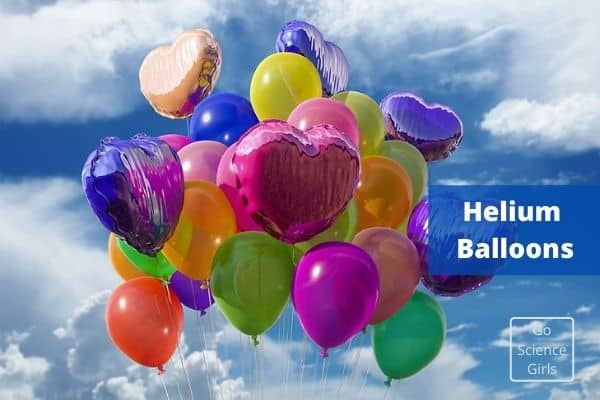
- Helium is lighter in density than air. This gives it the ability to float in the air and rise in a higher place the temper.
This belongings of Helium is used to fill balloons of all sizes, whether small political party balloons or big airships and blimps.
The calorie-free-weighted Helium keeps the balloons afloat and does not allow them sink.
Neon
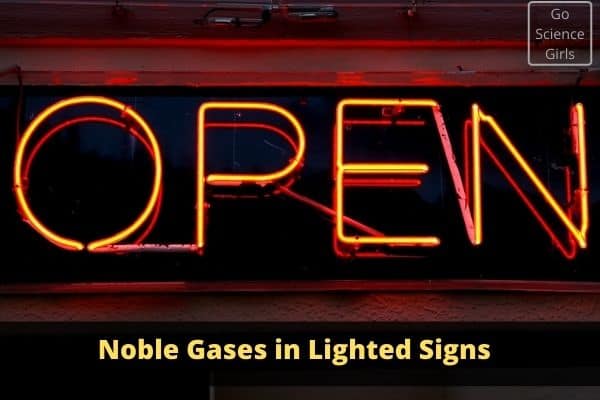
- You lot might accept heard about 'Neon Lights'. These Neon Lights is where Neon is used in eye-communicable billboards due to its emission of brilliant light.
Argon
- Argon is used in Light Bulbs. Here, Argon is a substitute for Air.
Since air reacts with the Tungsten material (another element from the Periodic Table), lite bulbs needed a non-reactive gas.
Hence, Argon is called because of its inertness.
Krypton
- Krypton is used in specific Lasers.
- In Headlamps, Krypton is used.
- It is besides used in Flat Panel Display.
- Another utilize of Krypton is as a filler in Double Glazing.
Double glazing is a type of glass setting, where two glass panels are filled with a gas betwixt them. This is washed to reduce the amount of incoming heat.
This filling gas is where Krypton is used due to its holding of Low Thermal Conductivity (low rut transmission).
If natural air is used as a filler, it will not lower the heat transmission due to its high thermal electrical conductivity.
Xenon
- Krypton is used in specific Lasers.
- It is also used in Flat Console Display.
- Since the early on 90s, Xenon is being used in Vehicle Headlights to improve route safety; this is because Xenon emits bright lights that enhance contrast and colour visions.
- In Medicine, Xenon is used as a natural anaesthetic. It makes the inhaler fall unconscious for a certain period so that the doctor tin can operate on them.
The heart rate and blood pressure level are meliorate monitored on the administration of Xenon as the sedative.
- In Satellites, Xenon is used as a Propeller that steers the movement of the satellite. This is considering Xenon is lighter in weight and hence can be manoeuvred easily.
Radon
- For the treatment of cancer, a process chosen Radiotherapy is used. The Radio in the Therapy because of the use of a radioactive chemical element.
Radon is used as that radioactive element.
(Oganesson'southward uses/applications are all the same under study)
Noble Gases Worksheets
Halogens and Noble Gases Anagrams – worksheet
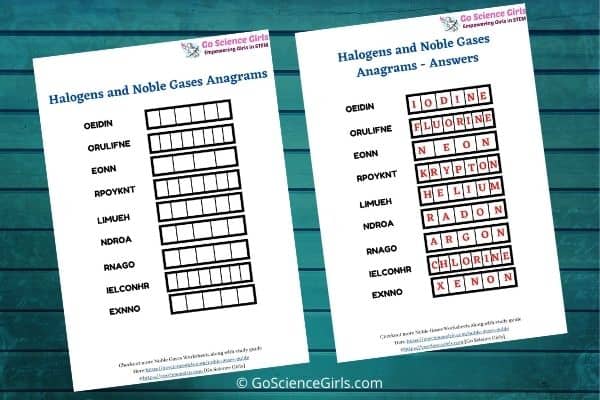
Download
Noble Gases – Word Search Activeness Worksheet

Download
Properties of Noble Gases worksheet
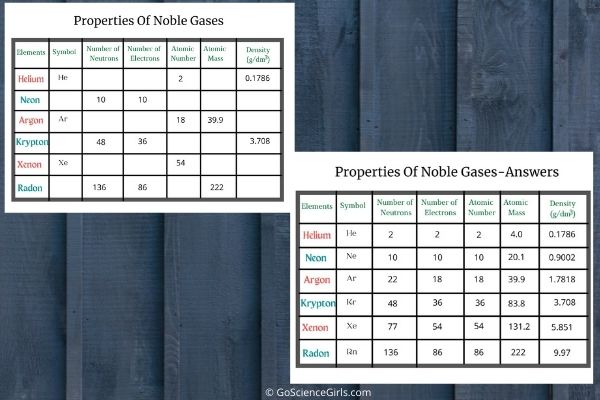
Download
Noble Gases Backdrop – Retention / Flash Bill of fare for Students
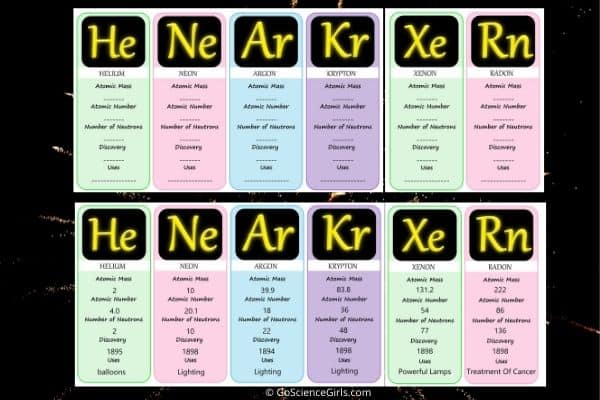
Download
Noble Gases Electron Configuration Worksheet
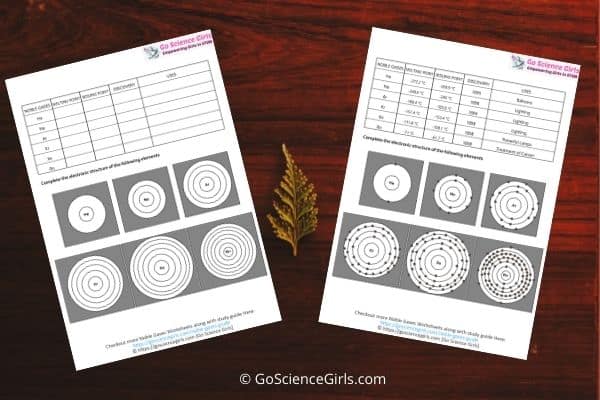
Download
Noble Gases have genuinely proven their proper name of having special and distinctive characteristics. Consequently, their applications and uses cannot be substituted with other elements of the periodic table.
There is speculation that there are still Noble Gases notwithstanding to be discovered. What wonder would they bring to the earth? Let's wait and sentinel.
Noble Gas Configuration For Helium,
Source: https://gosciencegirls.com/noble-gases-guide/
Posted by: broomfife1996.blogspot.com


0 Response to "Noble Gas Configuration For Helium"
Post a Comment